Related Research Articles
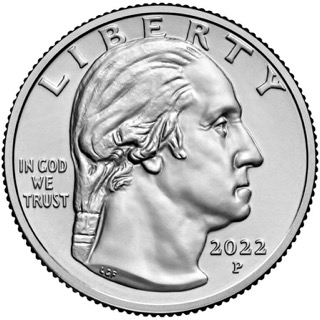
The quarter, short for quarter dollar, is a United States coin worth 25 cents, one-quarter of a dollar. The coin sports the profile of George Washington on its obverse, and after 1998 its reverse design has changed frequently. It has been produced on and off since 1796 and consistently since 1831.
Coins of the United States dollar were first minted in 1792. New coins have been produced annually and they make up a valuable aspect of the United States currency system. Today, circulating coins exist in denominations of 1¢, 5¢, 10¢, 25¢, 50¢, and $1.00. Also minted are bullion and commemorative coins. All of these are produced by the United States Mint. The coins are then sold to Federal Reserve Banks which in turn are responsible for putting coins into circulation and withdrawing them as demanded by the country's economy.

A nickel is a five-cent coin struck by the United States Mint. Composed of cupronickel, the piece has been issued since 1866. Its diameter is 0.835 inches (21.21 mm) and its thickness is 0.077 inches (1.95 mm).

The United States Mint is a bureau of the Department of the Treasury responsible for producing coinage for the United States to conduct its trade and commerce, as well as controlling the movement of bullion. It does not produce paper money; that responsibility belongs to the Bureau of Engraving and Printing. The first United States Mint was created in Philadelphia in 1792, and soon joined by other centers, whose coins were identified by their own mint marks. There are currently four active coin-producing mints: Philadelphia, Denver, San Francisco, and West Point.
The dollar coin is a United States coin with a face value of one United States dollar. Dollar coins have been minted in the United States in gold, silver, and base metal versions. Dollar coins were first minted in the United States in 1794.
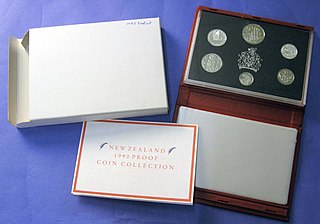
Proof coinage refers to special early samples of a coin issue, historically made for checking the dies and for archival purposes. Nowadays proofs are often struck in greater numbers specially for coin collectors (numismatists). Nearly all countries have issued proof coinage.

The United States three cent piece was a unit of currency equaling 3⁄100 of a United States dollar. The mint produced two different three-cent coins for circulation: the three-cent silver and the three-cent nickel. Additionally, a three-cent bronze coin was made as a pattern in 1863. During the period from 1865 to 1873, both coins were minted, albeit in very small quantities for the silver three-cent piece.
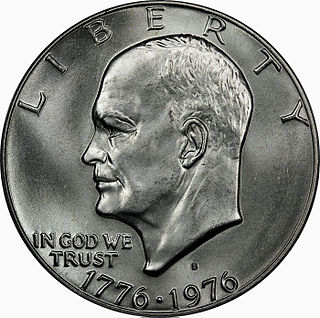
The United States Bicentennial coinage is a set of circulating commemorative coins, consisting of a quarter, half dollar and dollar struck by the United States Mint in 1975 and 1976. Regardless of when struck, each coin bears the double date 1776–1976 on the normal obverses for the Washington quarter, Kennedy half dollar and Eisenhower dollar. No coins dated 1975 of any of the three denominations were minted.

The quarter, short for quarter dollar, is a Canadian coin worth 25 cents or one-fourth of a Canadian dollar. It is a small, circular coin of silver colour. According to the Royal Canadian Mint, the official name for the coin is the 25-cent piece, but in practice it is usually called a "quarter", much like its American counterpart. In Canadian French, it is called a caribou or trente sous. The coin is produced at the Royal Canadian Mint's facility in Winnipeg, Manitoba.

The American Silver Eagle is the official silver bullion coin of the United States.

The Morgan dollar is a United States dollar coin minted from 1878 to 1904, in 1921, and beginning again in 2021 as a collectible. It was the first standard silver dollar minted since the passage of the Coinage Act of 1873, which ended the free coining of silver and the production of the previous design, the Seated Liberty dollar. It contained 412.5 Troy grains of 90% pure silver. The coin is named after its designer, United States Mint Assistant Engraver George T. Morgan. The obverse depicts a profile portrait representing Liberty, modeled by Anna Willess Williams, while the reverse depicts an eagle with wings outstretched. The mint mark, if present, appears on the reverse above between D and O in "Dollar".
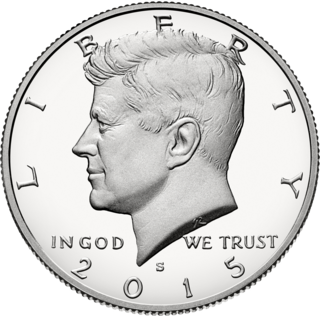
The Kennedy half dollar, first minted in 1964, is a fifty-cent coin issued by the United States Mint. Intended as a memorial to the assassinated 35th president of the United States John F. Kennedy, it was authorized by Congress just over a month after his death. Use of existing works by Mint sculptors Gilroy Roberts and Frank Gasparro allowed dies to be prepared quickly, and striking of the new coins began in January 1964.

The West Point Mint is a U.S. Mint production and depository facility erected in 1937 near the U.S. Military Academy in West Point, New York, United States. As of 2019 the mint holds 22% of the United States' gold reserves, or approximately 54,000,000 troy ounces (1,700,000 kg). The mint at West Point is second only to the gold reserves held in secure storage at Fort Knox. Originally, the West Point Mint was called the West Point Bullion Depository. At one point it had the highest concentration of silver of any U.S. mint facility, and for 12 years produced circulating Lincoln cents. It has since minted mostly commemorative coins and stored gold.
This glossary of numismatics is a list of definitions of terms and concepts relevant to numismatics and coin collecting, as well as sub-fields and related disciplines, with concise explanations for the beginner or professional.

Coin roll hunting is the hobby of searching and sorting coinage pulled from circulation for collectible coins. This is achieved through obtaining rolled coin, boxed coin, or bagged coin from banks and credit unions. A variant of this practice involves banknotes and is carried out in essentially the same fashion, normally to search for unusual serial numbers, star notes, and misprints.
The Royal Canadian Mint has made coins with various themes. Most recently, ice hockey has been used for many numismatic releases. The first known ice hockey coin was for the 1988 Winter Olympics. Issued on February 25, 1986, the coin featured a goalie on the coin. Edge lettering was also used for the coin, the first time that it was used on silver coins.
The America the Beautiful quarters were a series of fifty-six 25-cent pieces (quarters) issued by the United States Mint, which began in 2010 and lasted until 2021. The obverse (front) of all the coins depicts George Washington in a modified version of the portrait used for the original 1932 Washington quarter. There were five new reverse (back) designs each year, each commemorating a national natural or historic site such as national parks, national historic site, or national forests – one from each state, the federal district, and each territory. The program was authorized by the America's Beautiful National Parks Quarter Dollar Coin Act of 2008 (Pub. L. 110–456 .
The America the Beautiful silver bullion coins comprise a series of silver bullion coins with a face value of a quarter dollar. The coins contain five troy ounces of silver, making them the largest silver bullion coins ever issued by the United States Mint. The design of the coins duplicates exactly—though enlarged—each of the America the Beautiful quarters. They were issued from 2010 to 2021. The coins were available for sale during the year in which their corresponding circulating coin is issued. The coins are distributed by the United States Mint's network of authorized bullion dealers, and may be resold at the discretion of the Director of the National Park Service.
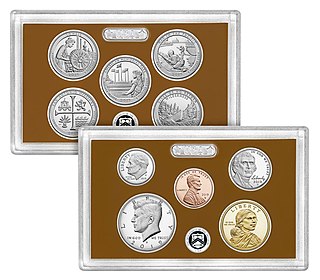
The United States Mint Proof Set, commonly known as the Proof Set in the United States, is a set of proof coins sold by the United States Mint. The proof set is popular with coin collectors as it is an affordable way to collect examples of United States coinage in proof condition.
The United States Uncirculated Coin Set, known as the Uncirculated Set or Mint Set in the United States, is an annual coin set sold by the United States Mint. The set is marketed towards coin collectors as a way to obtain circulation coins in mint condition.
References
- ↑ McMorrow-Hernandez, Joshua. "The Coin Analyst: What Are Your 50 State Quarters Worth Now?". coinweek.com. CoinWeek, LLC. Retrieved 5 February 2020.
- ↑ McMorrow-Hernandez, Joshua. "The Coin Analyst: What Are Your 50 State Quarters Worth Now?". coinweek.com. CoinWeek, LLC. Retrieved 5 February 2020.
- ↑ Gilkes, Paul. "2020-S America the Beautiful Quarters Silver Proof set sales launch Feb. 20". coinworld.com. Amos Media Company. Retrieved 5 February 2020.
- ↑ Gilkes, Pual. "2020-S America the Beautiful Quarters Silver Proof set sales launch Feb. 20". coinworld.com. Amos Media Company. Retrieved 5 February 2020.
- ↑ "United States Mint 2009 District of Columbia & U.S. Territories Quarters Proof Set Now Available". usmint.gov. United States Mint. Retrieved 4 February 2020.
- ↑ Potter, Ken. "Do you have a $10,000 edge error?". numismaticnews.net. Active Interest Media. Retrieved 4 February 2020.
- ↑ Gilkes, Paul. "Commemoratives in Prestige Proof sets". coinworld.com. Amos Media Company. Retrieved 4 February 2020.
- ↑ 2011 United States Mint Proof Set Certificate of Authenticity. The United States Mint. 2011.
- ↑ Martin, Erik. "Info for 1975 U.S. coin sets?". coinworld.com. Amos Media Company. Retrieved 7 February 2020.
- ↑ Morgan, Charles; Walker, Hubert. "Modern US Coins: Collecting the Ultimate 1981 Mint Set". coinweek.com. CoinWeek, LLC. Retrieved 7 February 2020.
- ↑ McMorrow-Hernandez, Joshua. "Collecting US Coins – Modern Rarities: 1982 & 1983 Souvenir Coin Sets". coinweek.com. CoinWeek, LLC. Retrieved 7 February 2020.
- ↑ "1999 Proof Sets Go On Sale". pcgs.com. Collectors Universe, Inc. Retrieved 7 February 2020.
- ↑ "Proof Sets, 2000-S Proof Set, 10 Piece PR". pcgs.com. Collectors Universe, Inc. Retrieved 7 February 2020.
- ↑ "2009 Lincoln Proof Cent Products". coinnews.net. CoinNews Media Group LLC. Retrieved 7 February 2020.
- ↑ "2009 United States Mint Silver Proof Set™ Available July 17". usmint.gov. United States Mint. Retrieved 7 February 2020.
- ↑ 1992 United States Mint Silver Proof Set Certificate of Authenticity. The United States Mint. 1992.
- ↑ 1999 United States Mint Silver Proof Set Certificate of Authenticity. The United States Mint. 1999.
- ↑ "Souvenir Sets". My Coin Guides. Retrieved 14 February 2017.
- ↑ "United States 1970-D Kennedy Half Dollar". coinweek.com. CoinWeek, LLC. Retrieved 4 February 2020.
- ↑ "United States 1973 (P) Eisenhower Dollar". coinweek.com. CoinWeek, LLC. Retrieved 4 February 2020.
- ↑ Zielinski, Michael. "1996-W Roosevelt Dime Celebrated 50th Anniversary". coinupdate.com. Coin Update. Retrieved 4 February 2020.
- ↑ "Click here to view larger image Image not actual size 2011 United States Mint Uncirculated Coin Set®". U.S. Mint Online Product Catalog. U.S. Department of the Treasury. Retrieved 16 October 2011.
- ↑ Unser, Mike. "US Mint Sales: 2017-S Enhanced Uncirculated Set Returns". coinnews.net. CoinNews Media Group LLC. Retrieved 11 March 2020.